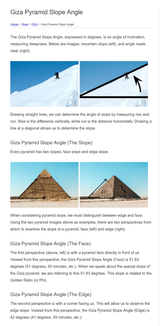Search Results
7/23/2025, 12:45:04 AM
To refer back to my earlier point regarding the origination arise of length of line difference changes occurring in a stepped metered, pattern following recipe,
we can use a gigantic triangle prism/base 4 equilateral pyramid for our example
We can make all of our points an equal distance apart from every other point, and then connect them with identical line lengths
OR, we can keep the base the same size, but pull the tip upwards, changing volume only at a single point, by collapsing the stack downwards in ratio into ever so smaller and smaller blocks but never outwards at the base, maintaining that area original ratio measurement
There is actually a name for the tippy top pull piece slider tool ratio adjuster mechanism
https://en.wikipedia.org/wiki/Pyramidion
At some point you can only pull so much, before you can not change the aspect size ratio any longer, that is the boundary bottom Plank layer
The blocks can no longer get any smaller in size in ratio
The ratio of all ratios is upon us
RUN FOR THE HILLS!
Run for your points and Liiinesss
Let us examine the difference in angle between face and edge of a base 4 Prism (triangle) using the Great Pyramid of Giza as our example.
This shows us a square to check the Great pyramid to see, just what angle did they build it?
This is a fun example to explain perspective like this because the great Pyramid of Giza is Phi
https://en.wikipedia.org/wiki/Phi
φ
ϕ
(Sounds like "If Agh Eyef Ugh" without the
Which originated as
https://en.wikipedia.org/wiki/Voiceless_bilabial_fricative
And then evolved into
https://en.wikipedia.org/wiki/Voiceless_bilabial_plosive
Which sounded like (Bah Ah Bahgh)
Not to be confused with Pi, the circle jerk
*Sigh*
Both sounds used to represent spoken Phi during it's evolution involve using a great many different parts of the body in different conjunctions and combinations of energy
https://en.wikipedia.org/wiki/Manner_of_articulation
we can use a gigantic triangle prism/base 4 equilateral pyramid for our example
We can make all of our points an equal distance apart from every other point, and then connect them with identical line lengths
OR, we can keep the base the same size, but pull the tip upwards, changing volume only at a single point, by collapsing the stack downwards in ratio into ever so smaller and smaller blocks but never outwards at the base, maintaining that area original ratio measurement
There is actually a name for the tippy top pull piece slider tool ratio adjuster mechanism
https://en.wikipedia.org/wiki/Pyramidion
At some point you can only pull so much, before you can not change the aspect size ratio any longer, that is the boundary bottom Plank layer
The blocks can no longer get any smaller in size in ratio
The ratio of all ratios is upon us
RUN FOR THE HILLS!
Run for your points and Liiinesss
Let us examine the difference in angle between face and edge of a base 4 Prism (triangle) using the Great Pyramid of Giza as our example.
This shows us a square to check the Great pyramid to see, just what angle did they build it?
This is a fun example to explain perspective like this because the great Pyramid of Giza is Phi
https://en.wikipedia.org/wiki/Phi
φ
ϕ
(Sounds like "If Agh Eyef Ugh" without the
Which originated as
https://en.wikipedia.org/wiki/Voiceless_bilabial_fricative
And then evolved into
https://en.wikipedia.org/wiki/Voiceless_bilabial_plosive
Which sounded like (Bah Ah Bahgh)
Not to be confused with Pi, the circle jerk
*Sigh*
Both sounds used to represent spoken Phi during it's evolution involve using a great many different parts of the body in different conjunctions and combinations of energy
https://en.wikipedia.org/wiki/Manner_of_articulation
Page 1
